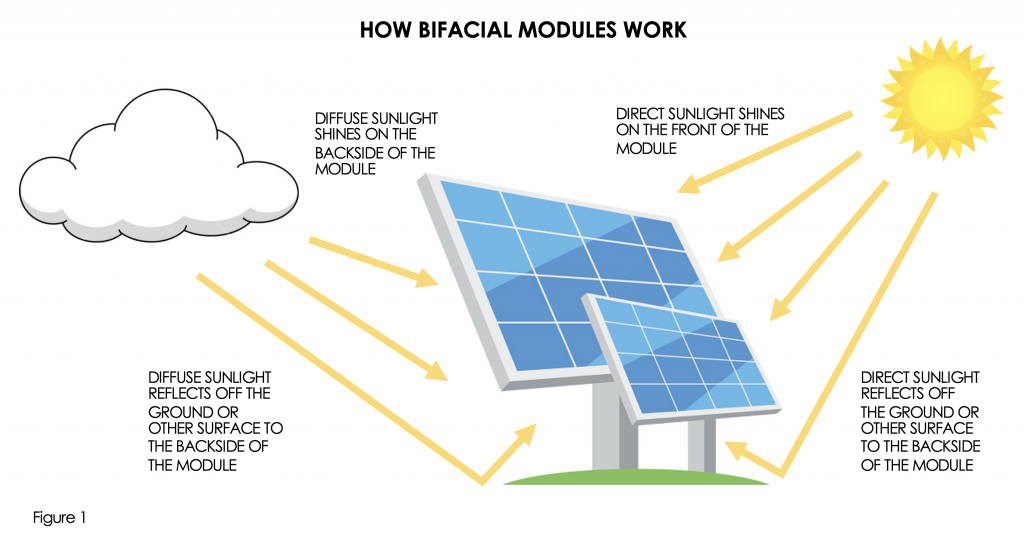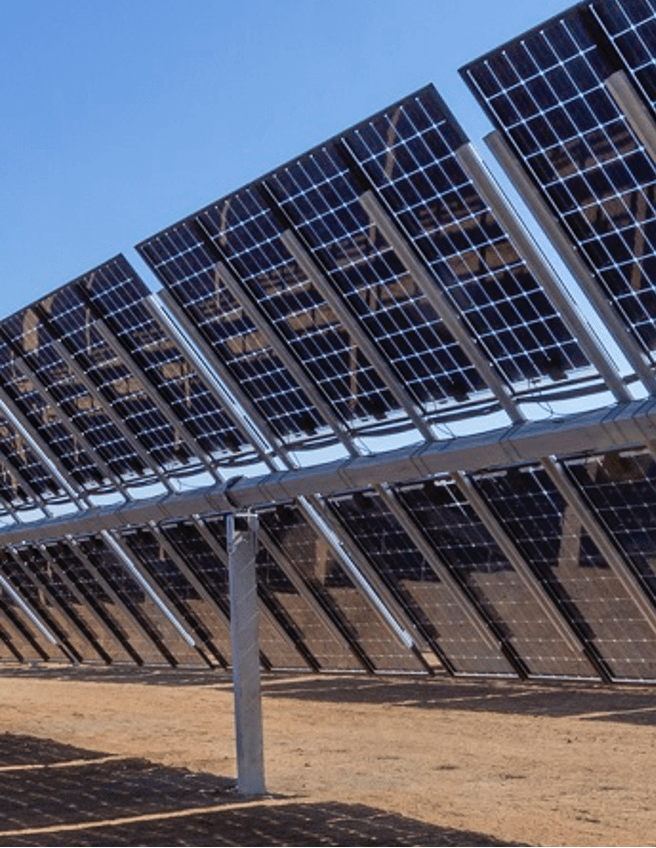(Part I) – 5 Minute Read
In this week’s Solar Coaster/Election Coaster edition of Kinect with Kurt, we’re going to examine bifacial modules. Unless you’ve been doing nothing but binge-watching Cobra Kai for the past few weeks (and who could blame you for that), you probably heard that the bifacial tariff exemption was revoked by President Trump. Enter Judge Katzmann of the US Court of International Trade, who blocked that proclamation and issued a 2-week restraining order against the president. Who knew that was even a thing? So, bifacial modules will remain exempt from tariffs, for a little while longer at least. Mercifully, this blog is not about tariffs or politics, so let’s dig in.
A Brief and Incomplete History of Bifacial Modules
Like many great inventions that profoundly impact our lives including microchips, barcodes, and big cars with tail fins, bifacial solar cells can trace their history back to the 1950s. The first solar cell developed by Bell labs and unveiled to the public in 1954 was bifacial – an n-type bifacial, interdigitated back contact solar cell, in case you were wondering. Bifacial modules have been with us ever since in one capacity or another. Russian satellites implemented bifacial technology in the 70s. The Swiss used bifacial modules beginning in the 90s to serve the dual purpose of energy production and noise barriers along roadways. And who could forget the Sanyo HIT Double bifacial modules from the aughts? Pretty impressive panels at a massive 200 watts circa 2008, and that was before backside gains! In the past few years, with the tariff exemption and decreasing manufacturing costs fueling their popularity, bifacial modules have come into their own. Large developers have been scooping them up for utility scale projects to take advantage of increased energy yield and potentially lower levelized cost of energy (LCOE). Meanwhile manufacturers and 3rd party organizations like NREL have been trying to accurately measure bifacial performance to determine how these modules perform under the vagaries of real-world conditions.
Bifacial Technology for Beginners
Simply put, bifacial modules are manufactured so both sides of the solar cells can be exposed to light and produce power. A glass or clear back sheet replaces the opaque back sheet and aluminum cell backing found on most monofacial modules. Typically, the front side absorbs direct sunlight while the backside captures sunlight reflected by the ground, rooftop, clouds, other solar modules, and so on.

Bifacial modules utilize PERC technology as well as PERT and Hetero-Junction technology like typical modern monofacial panels. They can be poly or monocrystalline but, following industry trends, tend to be mostly monocrystalline these days. Like monofacial modules, bifacials have an STC or nameplate rating based on ideal laboratory test conditions. Because STC ratings only account for frontside production, an additional rating is assigned based on the percentage gain from the backside.
So bifacials aren’t exotic or even new technology, but it’s worth noting that they do come with the bonus of real and potentially significant production gains. Accurately measuring those gains though is where the story gets a bit more complicated. Before we jump into the sticky wicket (yeah, that’s a Cricket metaphor) of predicting back side gains, let’s look at some of the advantages bifacial modules can have over monofacial modules and some of the potential drawbacks.
Bifacial Benefits
Here are some of the reasons you should consider bifacial modules:
- Aesthetics: Like almost everything to do with solar, beauty is in the eye of the beholder, or homeowners association, utility company etc. For me personally, dual glass bifacial modules can really add to the aesthetic appeal of a skylight, backyard pergola, or otherwise bland carport.
- Higher Efficiency: Higher energy yields are a reality with bifacial modules and can reach over 30% in ideal conditions. Per the spec sheet (and complex mathematical proof on my part), a 400-Watt Trina bifacial module with a backside gain of 25% becomes a 500-Watt module. Not too shabby! Keep in mind that those gains depend heavily on a whole raft of variables that we’ll look into in Part II.
- More Installation Options: Bifacial modules can be installed in any way monofacial modules can, but also excel in nontraditional ways. For instance, the Swiss highway sound barrier/ photovoltaic installation we spoke about earlier utilized vertically mounted modules.
- Easy Replacement: Bifacial modules utilize virtually identical technology as standard monofacial modules and have very similar mechanical and electrical characteristics. So replacing monofacials with bifacials is often a simple process involving no more than a few design tweaks.
- Higher Performance and Energy Density: With backside gains, production is increased and more energy per square foot is possible. Obviously, this is critical in areas with limited real estate for PV systems.
- Increased Durability: Because most bifacial modules are manufactured using glass on both sides, the modules are typically stronger and more durable. This equates to lower degradation rates and higher long-term energy yields over the life of the installation.
- Lower LCOE: Production gains (higher kWh/kWp compared to monofacials) as well as enhanced durability ultimately equate to lower LCOE – the holy grail of solar projects, especially at utility scales. This translates to increased margin and who couldn’t use that these days.
Bifacial Challenges
Like even the best things in life, bifacials do come with some drawbacks. Here are some reasons why bifacial modules may not be suitable for your next project:
- Price: The most significant disadvantage of bifacial modules is price. The materials and processes used to manufacture bifacial modules are simply more expensive. This added price has prevented bifacials from being more prominent even though the technology is more than 60 years old. However, the tariff exemption (if it holds) and a decreasing price difference between monofacial modules make this only a slight detractor, if at all in some cases.
- Racking: Specialized racking is needed to ensure that backside gains can be maximized. This means that racking hardware needs to be moved to the module edges to allow light to hit the entire backside. Single axis trackers, where bifacials can really excel, need to leave a significant space between module columns so the torque tube doesn’t “shade” the backs of the module (see Figure 2). Many racking manufacturers, especially those focused on ground mounts, have products specifically designed for bifacials. The downside is that this can add to the price. Although most bifacials now come with a frame, there are still some on the market that don’t, and those require specialized clamps to protect the module.
 . Figure 2
. Figure 2- System Design: We mentioned earlier that bifacial modules can replace monofacials fairly easily. But, designers and engineers need to be careful and take higher currents and voltages into account. Most inverters are designed to accommodate the increased power of a bifacial system, especially at commercial and utility scales. However, designers will need exercise caution and account for power increases when selecting inverters, wiring, and other BOS equipment.
- Installation: Because of those two sheets of glass, bifacial modules are heavier making installation and handling more difficult. Wire management also becomes critical to keep from blocking the backside of the module, which can add to installation time and complexity. The good news is that manufacturers have adjusted their module design with features like shorter cables that practically eliminate wire management.
- Backside Obstructions: For rooftop installations, MLPE needed to meet rapid shutdown requirements are unfortunately going to hinder backside gains and most rooftop racking isn’t designed with bifacials in mind. Imagine the rails running across the front face of the module and you get the idea. Really, any wiring or other equipment that’s hanging around the backside of the module has the potential to limit backside gains to almost nil.
- Production Modeling: Predicting the production of a monofacial PV array has become pretty straight ahead with tools like PV Syst and Helioscope. But backside gains are based on so many variables that just aren’t that easy to account for. Therefore, accurately predicting annual production of a bifacial PV system becomes more difficult and will involve timely and expensive manual calculations by your design and engineering team.
Parting Thoughts
Ultimately, bifacial modules are here to stay, with some manufacturers and industry analysts predicting they will eventually overtake monofacials as the go-to technology. So, it’s essential to learn about this technology today.
In part II, we’ll look at those situations where bifacials prevail and what factors contribute to their success. We’ll also attempt to determine what kind of gains are possible based on installation characteristics.
Until next time, thanks for reading and you stay sunny planet earth.